How to change a tire
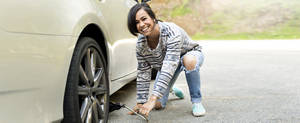
Roadside emergencies can happen to anyone at any time. This means you may need to change your tire on your own. With our guide and a little practice, you can be prepared.
Tires certainly take a beating, and occasionally you may need to replace one due to damage, low tread or irregular wear. Knowing when to replace your tires is important because old or damaged tires can become a safety hazard.
At America's Tire, we recommend replacing your tires after 6 years of age, regardless of tread depth. For your safety, we won't service a tire more than 10 years old.
Is your tire a goner? Let us recommend the best replacement with Treadwell, our smart tire buying guide that helps match you with the ideal tires for what, where and how you drive.
If there's an emergency, always remember not to panic. Focus on finding a safe place to pull over. You may need to briefly drive on a flat or low tire.
Instructions: Changing a Flat Tire
Ready to learn how to change a tire? We've got the full rundown below, as well as a quick video on how to change your tire in 10 easy steps!
Tools to change a tire
Before you start, make sure you have all the tools you need to successfully and safely change your tire. Many vehicles include a tire change kit with all these tools you need, but be sure to consult your owner's manual to double check what tools your vehicle is equipped with, and where they're located. Here are the tools we recommend having handy in your vehicle at all times:
- Jack
- Lug wrench
- Wheel chocks (if available)
- Spare tire
Pro tip: familiarize yourself with these tire changing tools (and where to find them) before you hit the road. Knowing how to use them will help you take care of the job with ease—even in an emergency
Changing a Tire Step-By-Step
Now that you're familiar with the tools you need to change your tire, how to use them and where to find them in your ride, let's breakdown the 10 easy steps for how to change a tire:
1. Park or pull over to a safe location.
Turn on your hazard lights and pull as far off the road as possible. If you're on the freeway, don't be afraid to continue driving to the next exit ramp.
Flat surfaces are best to change your tire. Gas stations, parking lots or any other paved surfaces are a good option. Dirt or grass, unlike pavement, can sink your jack. Never change your tire on a hill or around a curve where other vehicles cannot see you.
2. Activate your emergency brake
Stabilize your vehicle by throwing on the emergency brake. For automatic vehicles, make sure you're set to park. For manual transmissions, put it in gear.
Then, place wheel chocks or heavy rocks behind the tires opposite of the one you are changing. These act as additional security to make sure your vehicle doesn't roll away.
Pull out your lug wrench, jack and spare tire.
3. Remove your hubcap, if equipped
Skip this step if your wheel doesn't have a hubcap.
You can pry the hubcap off using a hubcap cool, screwdriver or flat end of the jack handle or lug wrench. Do this carefully by prying in a few places, like you would a paint lid can. If your hubcap is fastened with lug nuts, leave them on. You'll loosen them in the next step.
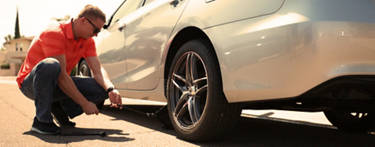
4. Loosen lug nuts
You'll need to loosen the lug nuts on the wheel before you can jack your car up. Don't remove the lug nuts completely yet.
Do this by rotating the wrench one turn, counter clockwise, on the first lug nut. Then, do the same to the nut directly opposite the first. Continue doing this so you make a star-shaped pattern. You may need to push down using your body weight if they are very tight.
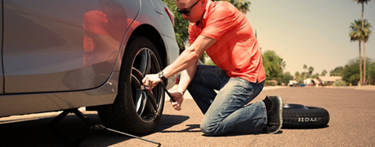
5. Use the jack to lift the vehicle
Once you've loosened the wheel's lug nuts, use the jack to lift the vehicle until the tire is fully raised off the ground.
Your owner's manual will have instructions on the best place to position the jack. It will also instruct you how to operate it. If your vehicle seems at all unstable, immediately lower the jack. You may need to reposition it.
Never position yourself where the car can land on your feet, hands or body while the vehicle is lifted.
6. Fully remove the loosened lug nuts and secure them
Remove the loosened lug nuts with your lug wrench and place them in a secure location.
Be careful as they are typically very hot from normal heat build-up caused by driving. If you have a hubcap, you can use it as a bowl to hold them. Keeping them in an isolated, easy to reach place will prevent loss and also help you avoid creating a dangerous environment for others on the road.
7. Pull the wheel and flat tire off the hub
Grasp the flat tire with two hands and pull it straight back towards your chest. If your tire was damaged, be careful not to grab any exposed metal cords on the tire.
Once removed, lay it under the car near the jack. The tire may possibly catch the vehicle if the jack should slip. If you have aftermarket wheels, remember to remove any wheel accessories from the hub, such as hub rings.
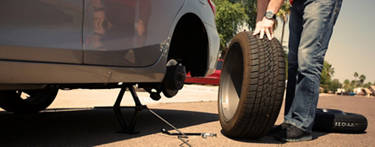
8. Attach the spare tire
Hold the spare up, align it with the wheel bolts, and push it securely onto the hub assembly (AKA mounting surface).
Install and hand tighten the lug nuts in the same star-shaped pattern that you used to remove them.
Tighten each lug nut as tightly as can be done by hand but do not apply so much force that the vehicle rocks or sways on the jack.

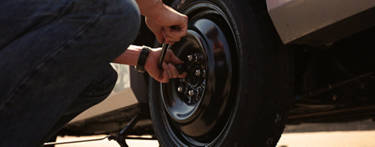
9. Lower the vehicle to the ground
Turn the jack handle to lower the vehicle until it touches the ground and can no longer spin freely.
Tighten the lug nuts using your wrench, again in the same star-shaped pattern.
Once fully tightened, remove the jack and wheel chocks.
When you're done, gather all of your tools and place them securely in your vehicle or trunk.
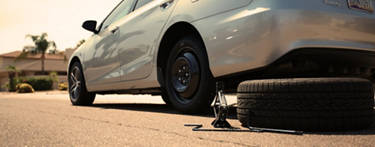
10. After care and maintenance
Now that you've got your spare safely installed, you're ready to make your way to a tire service station (or your neighborhood America's Tire) to get your flat taken care of with a tire inspection.
At America's Tire, we offer a suite of free tire repair and safety services. We may be able to repair your tire if there is minimal damage and the repair is within repair guidelines. If not, we're happy to help you find the right tire for the right price.
As you get back on the road, remember that many spare tires are smaller and less capable than regular tires. They aren't a permanent replacement for your flat. You should only use your spare tire to travel short distances, like driving to the tire shop to get a replacement.
Whether you simply need a flat repair or a brand new tire, don't delay your trip to take care of your damaged tire. You may also need to replace your spare tire after use; you don't want to be caught in an emergency without one.
We offer all the tire services you may need, including tire rotations. Regular tire maintenance is important in keeping your tires healthy!
Always feel free to give us a ring or drop by for more help. We'll get you taken care of. If you are buying new tires (or wheels), be sure to buy and book online to get a shorter wait time in-store!